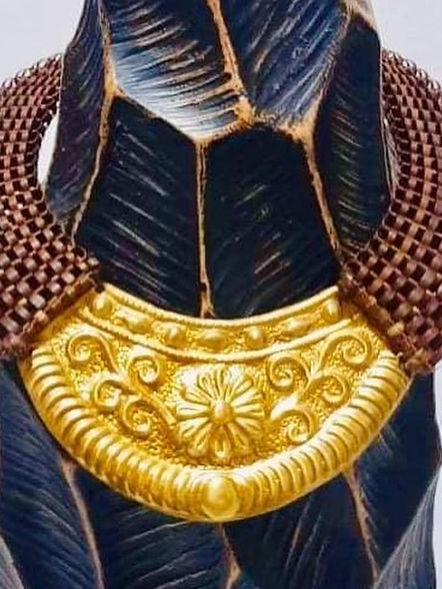
Journey as an Artist
The National Living Treasure came from modest beginnings in Apalit, Pampanga, where he assisted his farming parents in the field while growing up with nine siblings.
Mutuc is an artist who works in modest quarters for someone whose pieces hang in cathedrals and churches. His studio is shared with a tailor's shop in a corner of his yard.
The river next to his land overflowed during the most recent downpour, flooding his Apalit, Pampanga workshop and soaking his woodblocks. Mutuc is unaffected by anything.
He took a while to realize how talented he was at metalworking and sculpture. At the age of 29, he made the decision to substitute the somewhat safer vocation of woodcarving for his income from farming. He worked as an apprentice to domestic furniture carvers for his first year. Although it was challenging at first, he was able to acquire important skills from his mentors that would come in handy in the future. Though poverty was a strong motivator, learning about a job he knew nothing about beforehand proved to be the biggest obstacle for him.
Even though his wife and the first three of his nine children could not live comfortably on his P3.00 per day salary, the options available to a guy who had only completed elementary school were limited. After his fifth or sixth year of making furniture, he was taught the technique of silver plating by a coworker, and that's when things started to change. This method is frequently applied to imitate the gold and silver leaf used to decorate saints and sacred screens in colonial churches. Along with another acquaintance, he ventured out on his own after leaving the furniture store.
Monsignor Fidelis Limcauco commissioned him to make a tabernacle for the Fairview church in Quezon City, which was one of his earliest commissions. He started receiving commissions from clients to produce additional works, many of which are modeled after Spanish colonial styles. Christmas and Holy Week are the peak seasons. His own ideas are included into the final design, which he draws inspiration from traditional

Mutuc's Glory Days
Eduardo Mutuc is marked by his exceptional craftsmanship and dedication to the art of pinukpuk metalwork. His mastery expanded as he learned silver plating, known as pinukpuk, which involves intricate designs on metal sheets. His works, ranging from religious pieces like retablos and altars to secular creations, reflect a blend of Spanish colonial influences and his unique ideas.
Throughout his career, His meticulous approach to pinukpuk, where he pounds ornate designs onto metal sheets, has garnered him recognition, including the Gawad sa Manlilikha ng Bayan or National Living Treasures Award in 2004.
His dedication to preserving and passing on the art of pinukpuk is evident in his mentoring of young artisans in his hometown, ensuring the continuity of this beautiful tradition. Mutuc's craftsmanship, characterized by precise detailing and a deep understanding of historical and cultural significance, continues to shine through his works, enriching both religious and secular art forms.

PINOY NATIONAL ART FAIR ©

MUTUC'S ARTWORKS

Silver Candelabra
This artwork is a small decorative candelabra with the intended purpose of holding a candle and being put on display inside churches. It has intricate floral patterns all over its surface and was provided with a thick base for it to not fall over. This candelabra showcases Mutuc's craftsmanship and attention to detail, reflecting his mastery of metalwork and artistic expression


Pinukpuk Silver Metalwork
This artwork is a rectangular frame with seemingly floral and intricate patterns inside the frame with a circle as the centerpiece. It showcases his mastery in creating works of both secular and religious nature using silver, wood, and bronze mediums.


Crucifix
The was commissioned by Eduardo Mutuc in 2010. The commissioner requested that the cross be done in a Spanish colonial-era style, and so was it done. The cross has a strip of gold that drapes around the cross can be interpreted as a piece of clothing that priests wore. The streaks of gold at the back of the cross represent the holiness that it symbolizes, however, the skull at the bottom may represent the deaths of the people under the Spanish colonial rule through the spread of Christianity.


Agsam x Mutuc Banca Necklace
This artwork is a collaborative piece between the Filipino artist Agsam Agsam and Eduardo Mutuc. The necklace likely combines traditional Agsam weaving techniques with Mutuc’s contemporary artistic vision. This necklace represents a harmonious blend of tradition and innovation, showcasing the beauty and creativity of Filipino artisans.


Luntiang Ginto: Agsam Fern Bib Necklace
This artwork features intricately woven agsam ferns as the base of the bib necklace, accented with gold-plated pendants. The fusion of organic textures with the opulence of gold showcases his skillful craftsmanship and his ability to blend traditional Filipino materials with contemporary design aesthetics.


Agsam Fern Fashion Accessories

This artwork embodies a bohemian-chic style, celebrating the beauty of nature through skillful craftsmanship and the harmonious integration of various natural materials. He creates these accessories by weaving, twisting, or braiding the Agsam fern stems into intricate patterns, resulting in unique and environmentally friendly fashion pieces inspired by nature. These accessories often showcase the natural beauty and sustainability of materials sourced from the Philippines.





